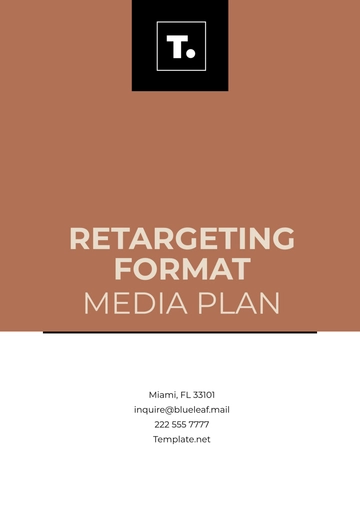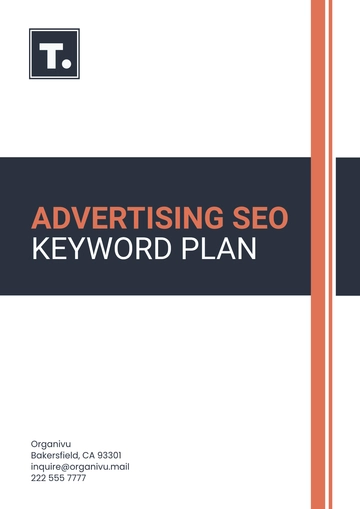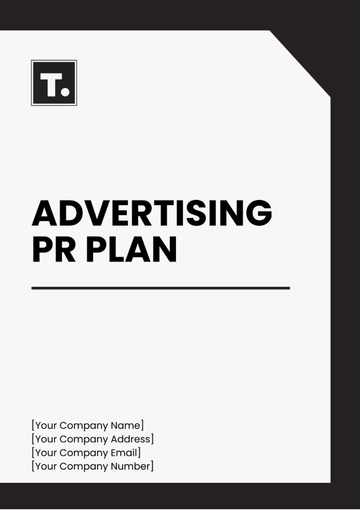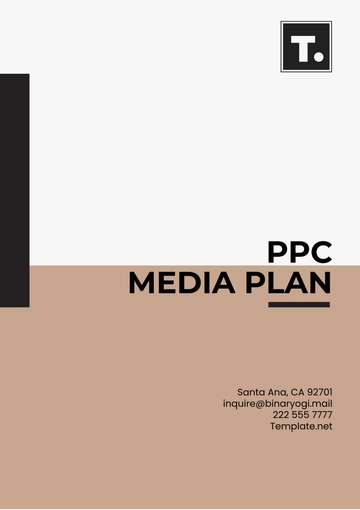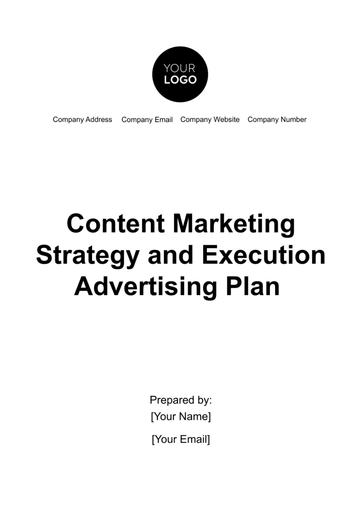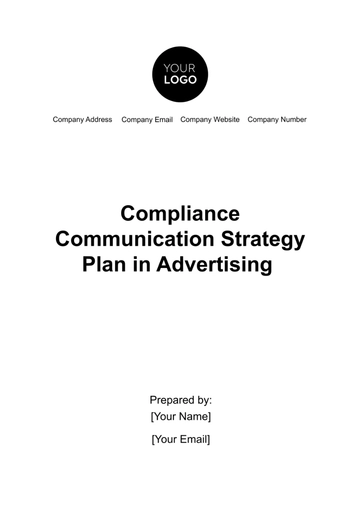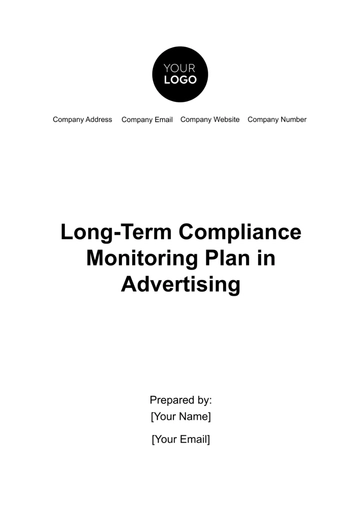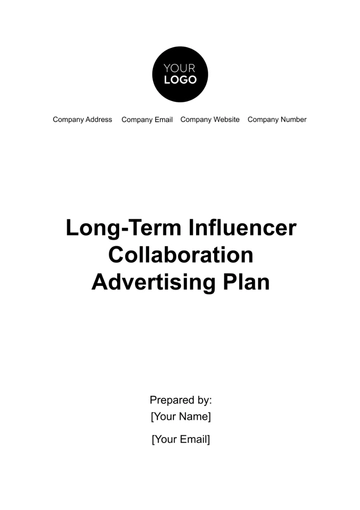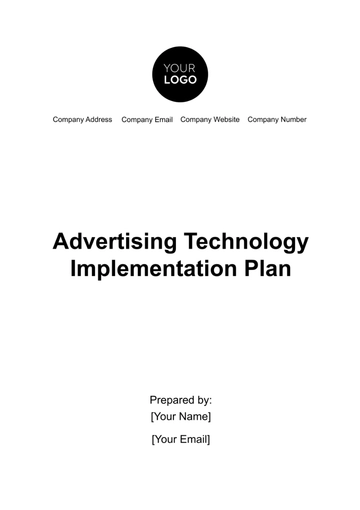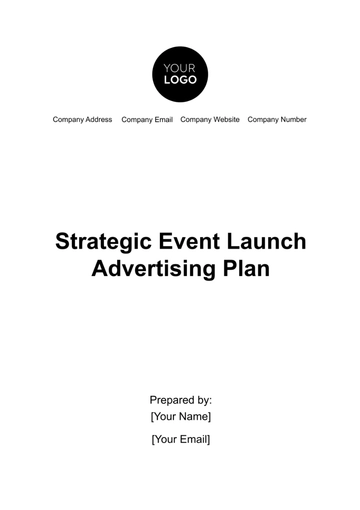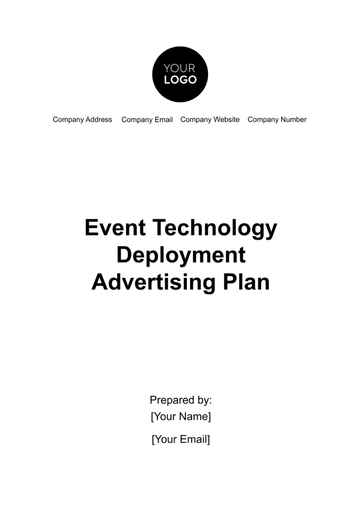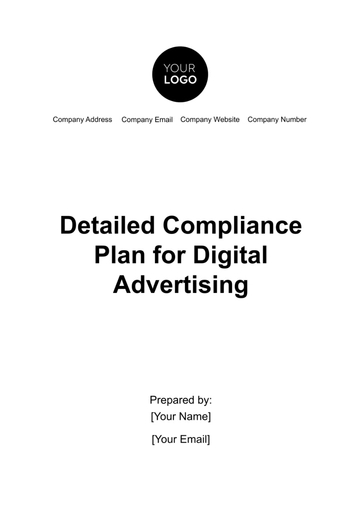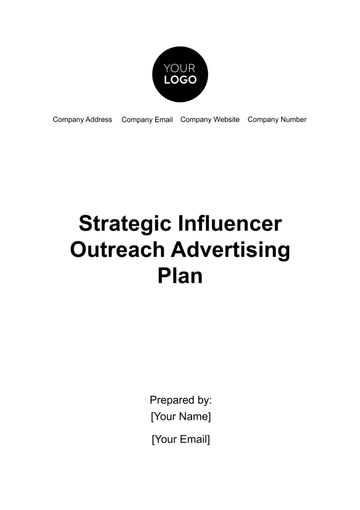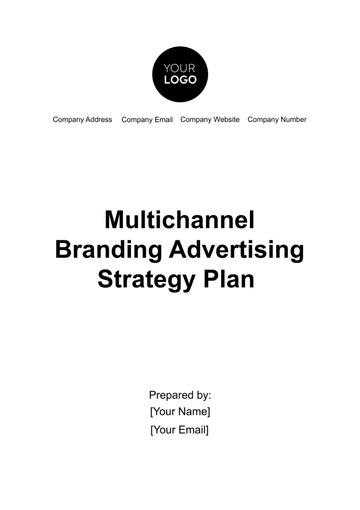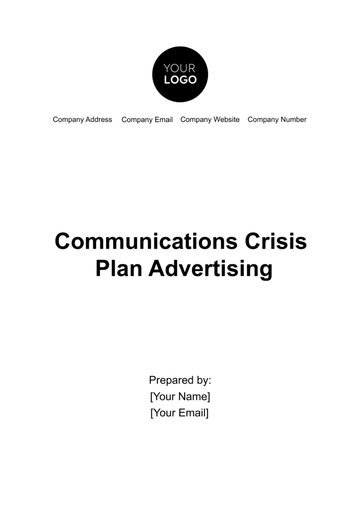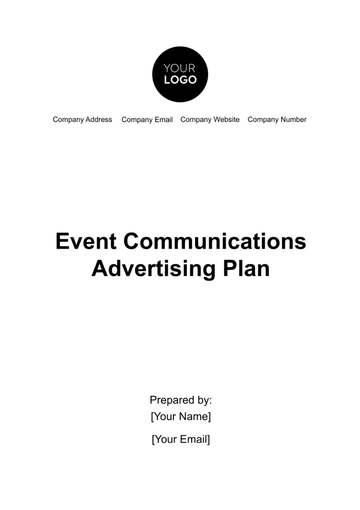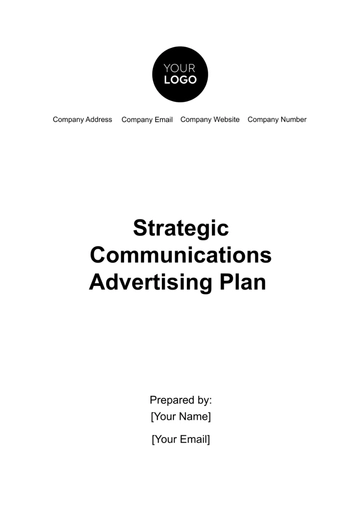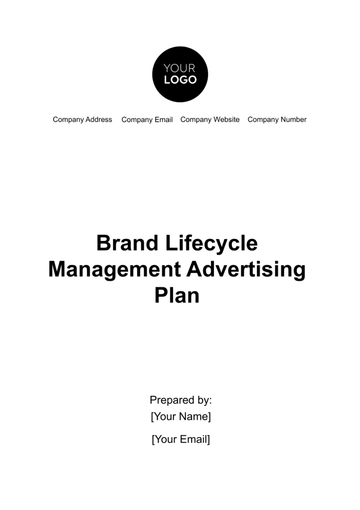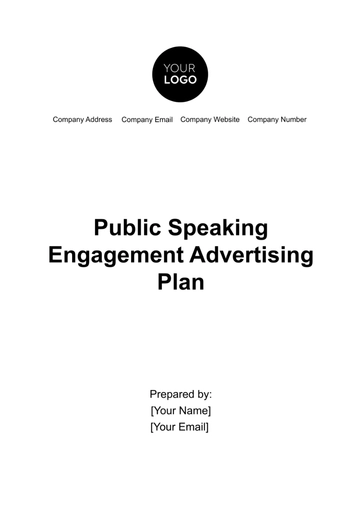Free Advertising Digital Brand Activation Plan
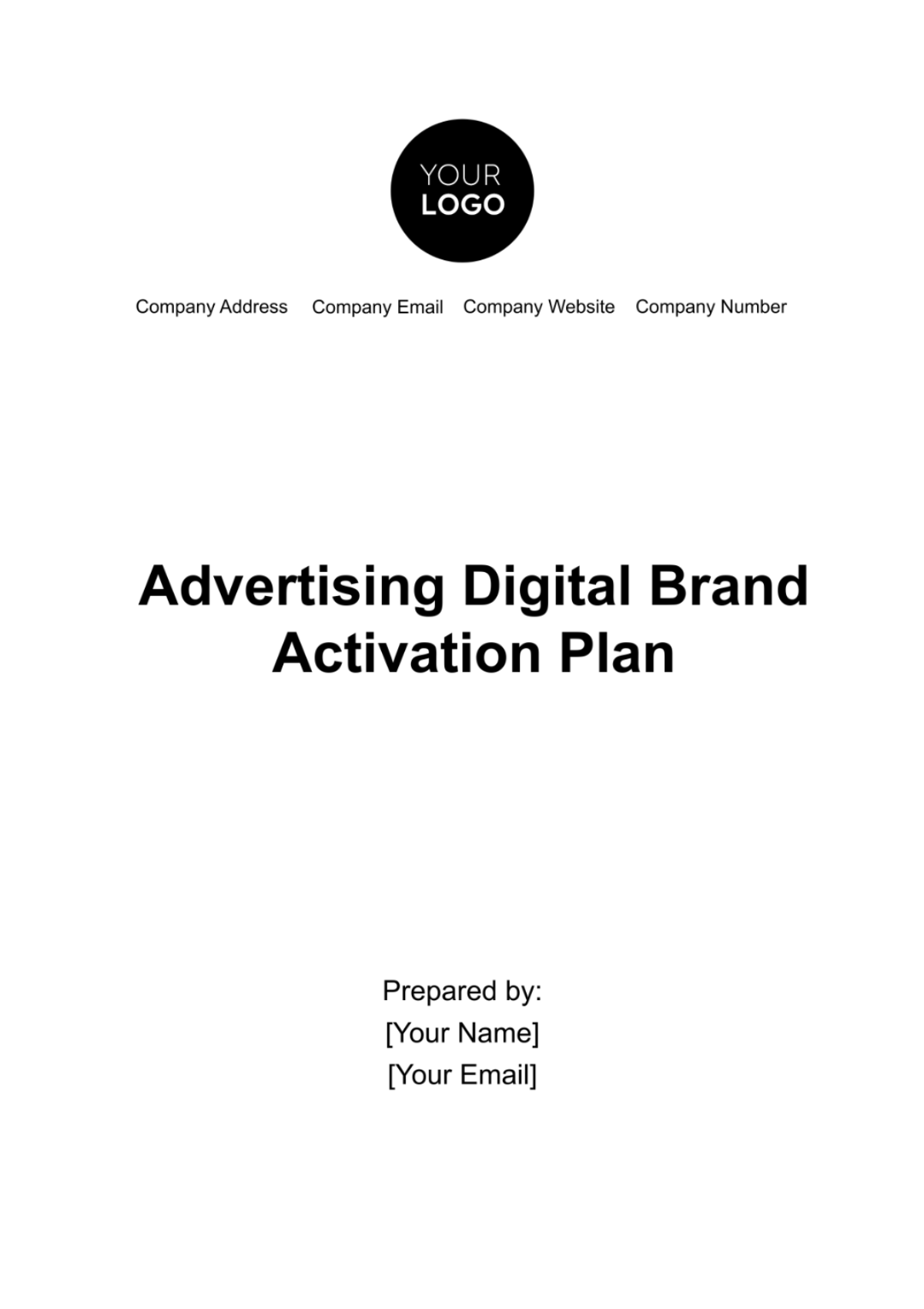
II. Introduction
In a world where conscious consumption is becoming a paramount concern, [Your Company Name] emerges as more than just a clothing brand. Rooted in the ethos of sustainability, innovation, and timeless style,[Your Company Name] stands at the forefront of a movement that redefines fashion, blending modern trends with a profound commitment to environmental responsibility.
[Your Company Name] isn’t just about creating beautiful clothing—it's a pledge to redefine the fashion landscape by embodying sustainability at its core. In an industry often marked by excess and rapid turnover, we believe in a different approach—one that champions longevity, ethical practices, and a deep respect for the environment.
Our target demographic encompasses the dynamic and socially conscious Millennials and Gen Z individuals seeking more than just a garment; they seek a narrative, a philosophy they resonate with. They value authenticity, actively participate in sustainability dialogues, and seek brands that mirror their values.
The Digital Brand Activation Plan for[Your Company Name] is a meticulously crafted blueprint, leveraging a multi-faceted approach across various digital touchpoints. From social media campaigns that authentically portray our sustainable journey to interactive website features designed for personalized shopping experiences, every facet of our strategy aims to resonate deeply with our audience.
We intend to harness the power of Instagram, TikTok, and Pinterest, employing each platform’s unique strengths to weave an engaging narrative. Through visual storytelling, user-generated content initiatives, and meaningful partnerships with eco-conscious influencers, we aim to not only captivate but also inspire our audience towards a more sustainable lifestyle.
Our collaborations extend beyond fashion—they symbolize our commitment to change. Partnering with environmental NGOs and integrating with sustainable fashion apps, we aim to support initiatives that align with our values, ensuring that every purchase contributes to a more sustainable future.
[Your Company Name]’s Digital Brand Activation Plan isn’t just a strategy—it’s a manifesto, a testament to our commitment to redefining fashion’s narrative. We invite you to embark on this journey with us, where style meets sustainability, and where every choice made is a step towards a better, more conscious world.
II. Brand Overview
A. Brand Name [Your Company Name]
The brand name encapsulates the essence of sustainability, modernity, and timelessness. It resonates with the target audience and represents a commitment to eco-conscious fashion practices.
B. Brand Identity
1. Modern: The brand exudes contemporary design aesthetics, keeping up with the latest fashion trends and innovative approaches in garment production.
2. Sustainable: Central to the brand's identity is a commitment to eco-friendly practices, including the use of organic materials, ethical manufacturing, and a reduced carbon footprint.
3. Trendy yet Timeless: Balancing trends with timeless elegance, the brand offers pieces that remain fashionable across seasons, promoting a 'buy less, choose well' philosophy.
C. Target Audience:
The brand primarily caters to Millennials and Gen Z individuals who are passionate about sustainability and ethical fashion. This demographic values authenticity, and social responsibility, and seeks stylish clothing that aligns with their values
III. Objectives
A. Increase brand awareness by 30% within six months
1. Strategies:
1.1 Social Media Campaigns: Develop a content calendar focused on sustainability, showcasing the brand's eco-friendly initiatives, manufacturing transparency, and impactful collaborations. Highlighting visually appealing products in these narratives.
1.2 Influencer Partnerships: Engage with influential figures who are passionate about sustainability, encouraging them to share their experiences with the brand through authentic and relatable content.
1.3 Initiatives: Forge partnerships with eco-friendly publications, contributing articles, or interviews about the brand's sustainable practices, collections, or initiatives.
B. Drive online sales by 25% in the next quarter
2. Approaches:
2.1 E-commerce Optimization: Conduct regular usability tests to enhance the website's user interface, focusing on seamless navigation, simplified checkout processes, and mobile responsiveness.
2.2 Promotion and Offers: Strategically time promotions around key events or sustainable milestones, offering discounts or exclusive access to limited edition sustainable collections.
2.3 Targeted Marketing Campaigns: Utilize data analytics to create targeted campaigns, retargeting visitors who showed interest in sustainable products but didn't complete a purchase.
IV. Digital Activation Plan
A. Social Media Campaigns
1. Instagram:
Create carousel posts or IGTV series detailing the brand's sustainable manufacturing journey, from sourcing materials to production processes.
IG Stories showing behind-the-scenes glimpses of designers, artisans, and eco-friendly practices.
2. TikTok:
Short, engaging videos showcasing the step-by-step process of creating sustainable garments.
DIY content using the brand's products to promote upcycling and creative reuse.
3. Pinterest:
Infographics and infotainment pins illustrating the environmental impact of various fabrics or detailing the brand's commitment to sustainability.
Create mood boards showcasing how to style the brand's clothing in versatile, sustainable ways.
B. Interactive Website
1. Features
Implement a sleek and intuitive website design ensuring a seamless shopping experience across all devices, employing high-quality visuals and easy navigation.
2. Personalization
Develop an AI-powered recommendation engine suggesting clothing items based on browsing history, past purchases, and style preferences, enhancing user engagement and encouraging repeat visits.
3. Sustainable Fashion Blog
Regularly publish blog posts covering a range of topics such as sustainable fashion trends, eco-friendly styling tips, interviews with designers, and deep dives into the brand's sustainability initiatives.
C. Virtual Events
1. Webinars
Host interactive webinars featuring industry experts discussing the future of sustainable fashion, eco-conscious styling tips, and the importance of ethical production practices.
2. Virtual Fashion Shows
Create an immersive online fashion show experience using 3D visualization technology, allowing viewers to virtually explore each garment, accompanied by live commentary from designers.
D. Influencer Marketing
1. Micro-Influencers
Empower local eco-friendly fashion enthusiasts to curate their collections or style guides featuring the brand's sustainable clothing, promoting authenticity and relatability.
2. Macro-Influencers
Partner with influential figures in sustainability, involving them in campaign launches, exclusive events, or cause-driven initiatives to amplify the brand's message on a larger scale.
These tailored strategies aim to leverage each platform's strengths, engaging audiences through immersive experiences, educational content, and influential partnerships, thereby reinforcing the brand's commitment to sustainable fashion in a captivating manner.
V. Metrics and Evaluation
A. Key Performance Indicators (KPIs)
Social Media Engagement Rates: Likes, Comments, Shares: Track the engagement metrics on each social media platform separately, analyzing the impact of content strategies and influencer collaborations.
Follower Growth: Monitor the growth in followers as an indicator of increased brand awareness and audience engagement.
Reach and Impressions: Assess the number of unique users who see the brand's content and the frequency of impressions.
Visitors and Sessions: Measure the number of unique visitors and sessions on the website, analyzing traffic sources (organic, social, referral).
Conversion Rate: Track the percentage of website visitors who complete a desired action, such as making a purchase or signing up for a newsletter.
Bounce Rate: Monitor the percentage of visitors who navigate away from the site without taking any action, assessing the effectiveness of landing pages and user experience.
B. Regular Analysis
1. Tracking KPIs
1.1 Weekly and Monthly Reports
Generate weekly and monthly reports that detail social media engagement metrics, website traffic sources, and conversion rates.
Compare performance metrics across different time frames to identify trends, spikes, or drops in engagement or conversion rates.
1.2 A/B Testing for Campaign Optimization
Conduct A/B testing on various elements of social media campaigns (such as content types, posting times, visuals) and website features (landing pages, checkout processes).
Analyze the results to determine which variations perform better, optimizing campaigns and website elements based on the findings.
2. Practical Implementation:
2.1 Social Media Tools:
Utilize social media analytics tools like Facebook Insights, Instagram Insights, TikTok Analytics, and Pinterest Analytics to track engagement rates, reach, and follower growth.
Implement Google Analytics or similar tools for monitoring website traffic, conversion rates, and user behavior on the site.
3. Custom Reporting:
Create custom dashboards or reports that consolidate key metrics from different platforms, allowing for a holistic view of performance.
Schedule regular reporting sessions to review the data and extract actionable insights.
C. Optimization Strategies:
Based on analysis findings, adjust social media content strategies, posting schedules, and website elements to optimize engagement rates and conversion rates.
Implement strategies derived from A/B testing to refine campaigns and website features continually.
VI. Budget Allocation
A. Social Media Ads: 30%
Platform Selection: Allocate funds across key platforms (Instagram, TikTok, Pinterest) based on user demographics, engagement rates, and the brand's historical performance on each platform.
Ad Types: Utilize a mix of ad formats (carousel ads, video ads, sponsored content) to diversify reach and engagement, focusing on sustainability narratives and product showcases.
Campaign Optimization: Regularly monitor ad performance, adjusting budgets and targeting parameters based on real-time data to maximize ROI.
B. Website Development and Maintenance: 20%
1. Development Costs: Invest in responsive design improvements, UX/UI enhancements, and features like AI-driven personalization, which require initial development costs.
2. Maintenance and Updates: Allocate funds for ongoing maintenance, security updates, and continuous improvements based on user feedback and industry best practices.
C. Influencer Partnerships: 15%
1. Influencer Fees: Allocate a portion of the budget towards compensating influencers for their collaborations, considering their reach, engagement rates, and alignment with the brand's values.
2. Content Creation: Factor in costs associated with content creation, production, and any sponsored posts or collaborations with influencers for brand-related campaigns.
D. Email Marketing: 10%
1. Email Automation Tools: Invest in email marketing platforms that enable automation, segmentation, and personalized email campaigns to reach different subscriber segments effectively.
2. Creative Content Costs: Allocate resources for creating visually appealing and engaging email content, including graphics, copywriting, and designing templates.
E. Virtual Events and Collaborations: 15%
1. Event Hosting Platforms: Set aside funds for using virtual event hosting platforms, ensuring a seamless experience for webinar participants or attendees of virtual fashion shows.
2. Collaboration Costs: Budget for collaborations with industry experts, influencers, or NGOs for hosting joint virtual events or campaigns promoting sustainability initiatives.
F. Analytics and Miscellaneous: 10%
1. Analytical Tools: Invest in advanced analytics tools or platforms to gather, analyze, and derive actionable insights from data collected across various digital channels.
2. Contingency Fund: Allocate a portion of the budget as a contingency to cover unforeseen expenses or emerging opportunities that might require additional financial resources.
VII. Conclusion
Your Company Name] strides forward not merely as a clothing brand but as a beacon of sustainability, innovation, and conscious consumerism. The Digital Brand Activation Plan crafted meticulously lays the groundwork for a transformative journey, one that transcends traditional boundaries and sets new benchmarks in the world of fashion.
A. Empowering Sustainability
Through engaging social media campaigns, strategic influencer partnerships, and a relentless pursuit of eco-consciousness,[Your Company Name] aspires to weave a narrative that marries style with sustainability. The brand's commitment to transparent practices, ethical manufacturing, and thought-provoking content positions it not just as a fashion label but as a catalyst for change.
B. Driving Impactful Engagement
The multifaceted approach, from optimizing the digital storefront to hosting immersive virtual events, aims not just at numbers but at fostering meaningful connections. By engaging in sustainable discussions, educational initiatives, and collaborations with NGOs,[Your Company Name] endeavors to create a community invested in mindful consumption and environmental stewardship.
C. Continual Growth and Evolution
The strategic budget allocations, meticulous analytics, and a penchant for adaptation form the bedrock of this plan. The aim isn't just to meet objectives but to exceed them by leveraging data-driven insights, refining strategies, and staying agile in an ever-evolving digital landscape.
D. A Call to Collective Action
As [Your Company Name] embarks on this digital odyssey, it extends an invitation—to customers, partners, and advocates of sustainability—to join hands in shaping a future where fashion isn't just an expression of self but a conscious choice that leaves a lasting impact on the planet.
In essence, this Digital Brand Activation Plan isn't merely a roadmap—it's a commitment, a testament to [Your Company Name]'s dedication to redefining fashion's narrative, one sustainable stitch at a time.
- 100% Customizable, free editor
- Access 1 Million+ Templates, photo’s & graphics
- Download or share as a template
- Click and replace photos, graphics, text, backgrounds
- Resize, crop, AI write & more
- Access advanced editor
Boost your brand's digital presence with the Advertising Digital Brand Activation Plan Template by Template.net. This editable and customizable tool, accessible in our Ai Editor Tool, equips marketers with a comprehensive plan to engage and resonate with their target audience online. Elevate your brand activation strategy effortlessly with this versatile template.
You may also like
- Finance Plan
- Construction Plan
- Sales Plan
- Development Plan
- Career Plan
- Budget Plan
- HR Plan
- Education Plan
- Transition Plan
- Work Plan
- Training Plan
- Communication Plan
- Operation Plan
- Health And Safety Plan
- Strategy Plan
- Professional Development Plan
- Advertising Plan
- Risk Management Plan
- Restaurant Plan
- School Plan
- Nursing Home Patient Care Plan
- Nursing Care Plan
- Plan Event
- Startup Plan
- Social Media Plan
- Staffing Plan
- Annual Plan
- Content Plan
- Payment Plan
- Implementation Plan
- Hotel Plan
- Workout Plan
- Accounting Plan
- Campaign Plan
- Essay Plan
- 30 60 90 Day Plan
- Research Plan
- Recruitment Plan
- 90 Day Plan
- Quarterly Plan
- Emergency Plan
- 5 Year Plan
- Gym Plan
- Personal Plan
- IT and Software Plan
- Treatment Plan
- Real Estate Plan
- Law Firm Plan
- Healthcare Plan
- Improvement Plan
- Media Plan
- 5 Year Business Plan
- Learning Plan
- Marketing Campaign Plan
- Travel Agency Plan
- Cleaning Services Plan
- Interior Design Plan
- Performance Plan
- PR Plan
- Birth Plan
- Life Plan
- SEO Plan
- Disaster Recovery Plan
- Continuity Plan
- Launch Plan
- Legal Plan
- Behavior Plan
- Performance Improvement Plan
- Salon Plan
- Security Plan
- Security Management Plan
- Employee Development Plan
- Quality Plan
- Service Improvement Plan
- Growth Plan
- Incident Response Plan
- Basketball Plan
- Emergency Action Plan
- Product Launch Plan
- Spa Plan
- Employee Training Plan
- Data Analysis Plan
- Employee Action Plan
- Territory Plan
- Audit Plan
- Classroom Plan
- Activity Plan
- Parenting Plan
- Care Plan
- Project Execution Plan
- Exercise Plan
- Internship Plan
- Software Development Plan
- Continuous Improvement Plan
- Leave Plan
- 90 Day Sales Plan
- Advertising Agency Plan
- Employee Transition Plan
- Smart Action Plan
- Workplace Safety Plan
- Behavior Change Plan
- Contingency Plan
- Continuity of Operations Plan
- Health Plan
- Quality Control Plan
- Self Plan
- Sports Development Plan
- Change Management Plan
- Ecommerce Plan
- Personal Financial Plan
- Process Improvement Plan
- 30-60-90 Day Sales Plan
- Crisis Management Plan
- Engagement Plan
- Execution Plan
- Pandemic Plan
- Quality Assurance Plan
- Service Continuity Plan
- Agile Project Plan
- Fundraising Plan
- Job Transition Plan
- Asset Maintenance Plan
- Maintenance Plan
- Software Test Plan
- Staff Training and Development Plan
- 3 Year Plan
- Brand Activation Plan
- Release Plan
- Resource Plan
- Risk Mitigation Plan
- Teacher Plan
- 30 60 90 Day Plan for New Manager
- Food Safety Plan
- Food Truck Plan
- Hiring Plan
- Quality Management Plan
- Wellness Plan
- Behavior Intervention Plan
- Bonus Plan
- Investment Plan
- Maternity Leave Plan
- Pandemic Response Plan
- Succession Planning
- Coaching Plan
- Configuration Management Plan
- Remote Work Plan
- Self Care Plan
- Teaching Plan
- 100-Day Plan
- HACCP Plan
- Student Plan
- Sustainability Plan
- 30 60 90 Day Plan for Interview
- Access Plan
- Site Specific Safety Plan

